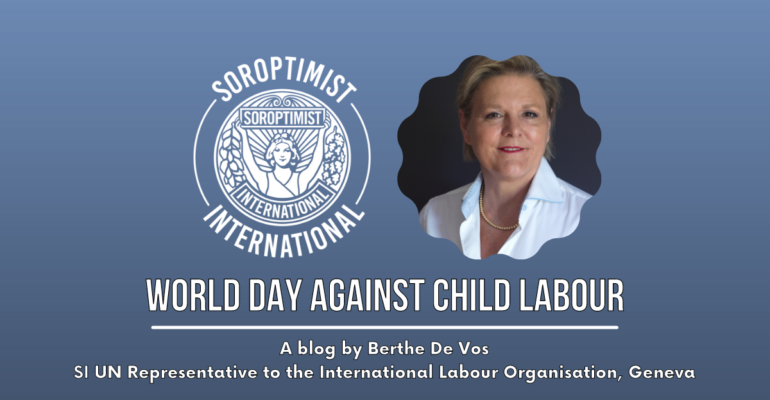Blog by Berthe De Vos, SI Representative to the International Labour Organisation.
“What is Child Labour? Child labour is work that harms the health of the child, endangers it, and it is a violation of international and/or national laws. It deprives children of education and/or puts a double burden on their studies and work. The worst form of child labour is slavery. Young slaves, separated from their families, are exposed to physical danger or illness, and are left alone in the streets of cities. Whether the form of work is called “child labour” depends on different factors: the child’s age, the nature and duration of the work, the conditions under which it is performed, and the end result. Depending on the region or country the answer will be different. Hence, the need of an international approach. At the creation of the International Labor Organization (ILO) in 1919 one of the main goals was to eliminate child labour. The principle that minimum age standards should be linked to schooling has always been part of the ILO’s ambition.
Until today the ILO works to achieve the effective abolition of child labour. The ILO conventions C182 (Worst forms of Child Labour), C183 (Minimum Age), IPEC (ILO’s Program on Child Labour) and in 2015 with the adaptation of the SDGs, specifically target 8.7, make it possible to renew the commitment by the State Members to end child labour over and over again.
To give an extra focus on the problem of child labour, the actions and efforts are needed. In this perspective the ILO launched in 2002 the “World Day Against Child Labour” on June 12th.
This year is marked by 20th anniversary the World Day Against Child Labour with the theme “Universal Social Protection to End Child Labour.” Today the ILO, together with its partners, is calling for increased input in social protection systems and schemes to establish solid social protection floors and protect children from child labour.
This year the World Day Against Child Labour comes after the 5th Global Conference on the Elimination of Child Labour (May 15-20, 2022) where the universal access to social protection was adapted as an integral part of the “Durban Call to Action”. This is a crucial part to help construct a path towards a world free of child labour, as mentioned in SDG 8.7, and towards universal social protection, as reflected in SDG 1.3. Also during this Conference the report of ILO & UNICEF on social protection and child labour was released with dreadful results.
In one of his last speeches as Director-General of the ILO, Guy Ryder warns that the choices made by governments now will make or break the lives of millions of children. He says that social protection is one of the most powerful measures to prevent child labor, providing families with income security in difficult times.
As we know, social protection is a human right and an effective political tool to prevent families from using their children for work. Currently 160 million children are engaged in child labour, some of whom are only five years old. This is almost 1 in 10 children in the world. Public safety nets are essential to eradicate and prevent child labour. Before the pandemic, a staggering 53.1 percent of the world’s population was unprotected. Unfortunately, coverage for children is even lower, with about three-quarters or 1.5 billion children not receiving any Social Security or protection.
The call for more investment in child-friendly social security systems to protect children from forced child labour and allow them to go to school is distressing. Child labour deprives children of their right to education, which is key to tackling child labour. Women and girls are even more deprived from this human right. And we all know that educated women are far more likely to avoid their children to be engaged in child labour. Moreover, we must remember that it also affects children who choose to remain in school, reducing their motivation and performance. Short-term policies that put pressure on social security systems need to be reviewed and reformed at international and national level.
Last but not least, during the 110th session of International Labour Conference an event was organised by the ILO to open the discussion on this topic and to discuss the results of the report ILO & UNICEF, in which most studies confirm the link between child labour and social protection.
Only by giving children access to social protection will we eliminate child labour. Actions is needed by all Member States.”

